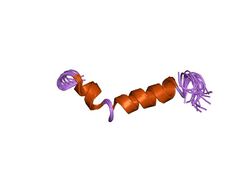Biology:Pardaxin
| Pardaxin | |||||||||
|---|---|---|---|---|---|---|---|---|---|
 twenty lowest energy structures of pa4 by solution nmr | |||||||||
| Identifiers | |||||||||
| Symbol | Pardaxin | ||||||||
| Pfam | PF07425 | ||||||||
| InterPro | IPR009990 | ||||||||
| TCDB | 1.A.66 | ||||||||
| OPM superfamily | 208 | ||||||||
| OPM protein | 1xc0 | ||||||||
| |||||||||
Pardaxin is a peptide produced by the Red Sea sole (P4, P5) and the Pacific Peacock sole (P1, P2, P3) that is used as a shark repellent.[1][2][3] It causes lysis of mammalian and bacterial cells, similar to melittin.[4]
Synthesis
In the lab, pardaxin is synthesized using an automated peptide synthesizer. Alternatively, the secretions of the Red Sea sole can be collected and purified.
Functions
Antibacterial peptide
Pardaxin has a helix-hinge-helix structure. This structure is common in peptides that act selectively on bacterial membranes and cytotoxic peptides that lyse mammalian and bacterial cells.[4] Pardaxin shows a significantly lower hemolytic activity towards human red blood cells compared to melittin. The C-terminal tail of pardaxin is responsible for this non-selective activity against the erythrocytes and bacteria.[4] The amphiphilic C-terminal helix is the ion-channel lining segment of the peptide. The N-terminal α-helix is important for the insertion of the peptide to the lipid bilayer of the cell.[5]
The mechanism of pardaxin is dependent on the membrane composition. Pardaxin significantly disrupts lipid bilayers composed of zwitterionic lipids, especially those composed of 1-palmitoyl-2-oleoyl-phosphatidylcholine (POPC). This suggests a carpet mechanism for cell lysis.[6] The carpet mechanism is when a high density of peptides accumulates on the target membrane surface. The phospholipid displacement changes in fluidity, and the cellular contents leak out.[7] The presence of anionic lipids or cholesterol was found to reduce the peptide's ability to disrupt bilayers.[6]
Shark repellent
P. marmoratas and P. pavoninus release pardaxin when threatened by sharks. Pardaxin targets the gills and pharyngeal cavity of the sharks. It results in severe struggling, mouth paralysis, and temporary increase of urea leakage in the gills.[1] This distress is caused by the attack of the cellular membrane of the gills, which causes a large influx of salt ions. Research into creating a commercial shark repellent using pardaxin was discontinued because it dilutes in the water too quickly. It is only effective if sprayed almost directly into a shark's mouth.[8]
Cancer treatment
Pardaxin inhibits proliferation and induces apoptosis of human cancer cell lines. Its 33-amino acid structure contains many cationic and amphipathic amino acids. This makes it easier for it to interact with anionic membranes, such as those in tumor cells, which are inherently more acidic because of the acidic environment created by more glycolysis.[9]
Pardaxin initiates caspase-dependent and caspase-independent apoptosis in human cervical carcinoma cells. Pardaxin triggers reactive oxygen species (ROS). ROS production disrupts protein folding and induces the unfolded protein response (UPR). This causes stress on the endoplasmic reticulum, which releases calcium. This leads to an increase in mitochondrial calcium, dropping its membrane potential. The pore permeability changes, and Cytochrome c (Cyt c) is released. Cyt c activates the caspase chain that leads to apoptosis. ROS also activates the JNK pathway. JNK is phosphorylated, which leads to the phosphorylation of AP-1 (transcription factor consisting of cFOS and Cjun). This results in the activation of caspases as well. ROS also causes a caspase independent pathway that results in apoptosis. When the mitochondrial membrane potential changes, apoptosis-inducing factors (AIFs) are also released. These trigger apoptosis when they enter the nucleus, not needing to involve caspases.[9]
References
- ↑ 1.0 1.1 "Pharyngeal cavity and the gills are the target organ for the repellent action of pardaxin in shark". Experientia 41 (5): 693–5. May 1985. doi:10.1007/bf02007726. PMID 3996550.
- ↑ "Sequencing and synthesis of pardaxin, a polypeptide from the Red Sea Moses sole with ionophore activity". FEBS Letters 242 (1): 161–6. December 1988. doi:10.1016/0014-5793(88)81007-x. PMID 2462511.
- ↑ "Isolation, characterization and synthesis of a novel paradaxin isoform". FEBS Letters 435 (2–3): 173–7. September 1998. doi:10.1016/S0014-5793(98)01057-6. PMID 9762902.
- ↑ 4.0 4.1 4.2 "A class of highly potent antibacterial peptides derived from pardaxin, a pore-forming peptide isolated from Moses sole fish Pardachirus marmoratus". European Journal of Biochemistry 237 (1): 303–10. April 1996. doi:10.1111/j.1432-1033.1996.0303n.x. PMID 8620888.
- ↑ "Channel formation properties of synthetic pardaxin and analogues". The Journal of Biological Chemistry 265 (33): 20202–9. November 1990. doi:10.1016/S0021-9258(17)30490-8. PMID 1700783. http://www.jbc.org/content/265/33/20202.long.
- ↑ 6.0 6.1 "Membrane composition determines pardaxin's mechanism of lipid bilayer disruption". Biophysical Journal 83 (2): 1004–13. August 2002. doi:10.1016/s0006-3495(02)75226-0. PMID 12124282. Bibcode: 2002BpJ....83.1004H.
- ↑ "Mechanisms of antimicrobial peptide action and resistance". Pharmacological Reviews 55 (1): 27–55. March 2003. doi:10.1124/pr.55.1.2. PMID 12615953.
- ↑ Sisneros, Joseph; Nelson, Donald (2001). "Surfactants as chemical shark repellents: Past, present, and future". The behavior and sensory biology of elasmobranch fishes: An anthology in memory of Donald Richard Nelson. Developments in environmental biology of fishes. 60. 117–129. doi:10.1007/978-94-017-3245-1_9. ISBN 978-90-481-5655-9. http://faculty.washington.edu/sisneros/Sisneros%20and%20Nelson%202001.pdf.
- ↑ 9.0 9.1 "Proteomic analysis reveals that pardaxin triggers apoptotic signaling pathways in human cervical carcinoma HeLa cells: cross talk among the UPR, c-Jun and ROS". Carcinogenesis 34 (8): 1833–42. August 2013. doi:10.1093/carcin/bgt130. PMID 23615400.
 |


